Recovery EAA
Recovery EAA
8 in stock
Couldn't load pickup availability
Share
What is Recovery EAA?
What is Recovery EAA?
Recovery EAA is for anyone looking to promote lean muscle gains, reduce post workout soreness, and lose weight. It is for the mild 30 minute walker, the weight lifter, the athlete, the elderly...literally anyone. Recovery EAA was created for those who have trouble meeting daily protein goals and would benefit from a zero calorie, more efficient, muscle building supplement in conjunction with their diet.
Features & Benefits
Features & Benefits
7400mg EAAs
Nine Essential Aminos
550mg Electrolyte Hydration Matrix
30 Servings
No Artificial Colors
No Artificial Flavors
What can Recovery EAA do?
What can Recovery EAA do?
With one scoop of Recovery you can experience:
Reduced post workout soreness
Lean muscle gains
Keep muscles fueled/fed during a fast (Fuller Look)
Promote muscle synthesis
Weight Loss
How to use
How to use
Mix 10g (1 SCOOP) with 6-8oz of water or your selected cold beverage. IT WILL TAKE A FEW MINUTES FOR ALL THE POWDER TO DISSOLVE IN THE BEVERAGES.
For Maximum Effectiveness: BEST TAKEN PRE/POST WORKOUT OR BETWEEN MEALS with a 1 hour wait, and not with another active protein source.
Ingredients
Ingredients
EAA Amino Blend (Theonine, L-Lysine, Phenylalanine,
Methionine, Histidine, Tryptophan) — 2400 mg
L-Leucine — 2500 mg
L-Isoleucine — 1250 mg
L-Valine — 1250 mg
Electrolyte Blend (Sodium Chloride, Potassium Citrate,
Magnesium Citrate, Calcium, Carbonate) — 550 mg
Other Ingredients
Inulin (Chicory Root), Malic Acid, Sucralose, Citric Acid, Silicon Dioxide.
Product Warning
Product Warning
Product does NOT contain major allergens such as dairy, nuts or soy.
Return/Refund
Return/Refund
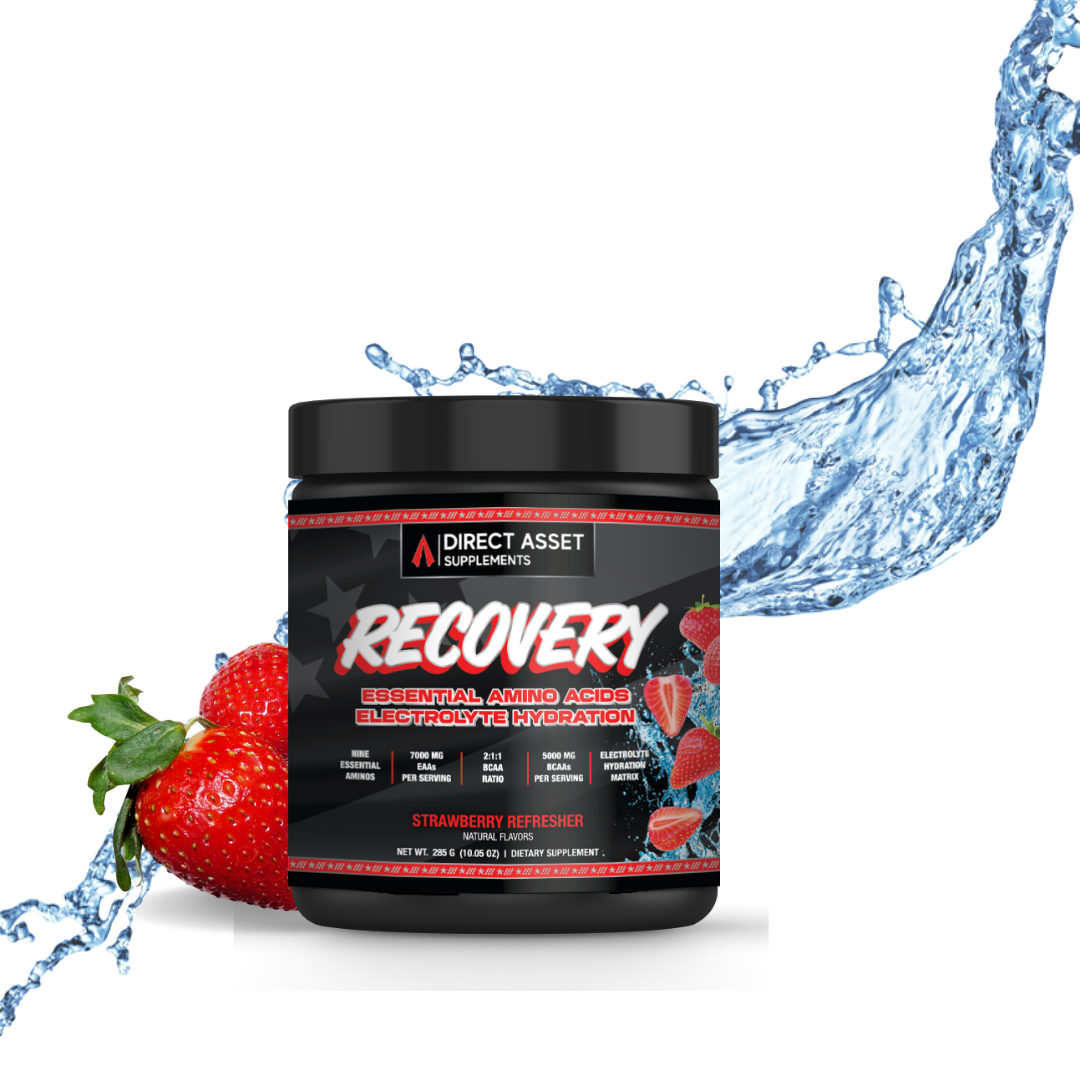
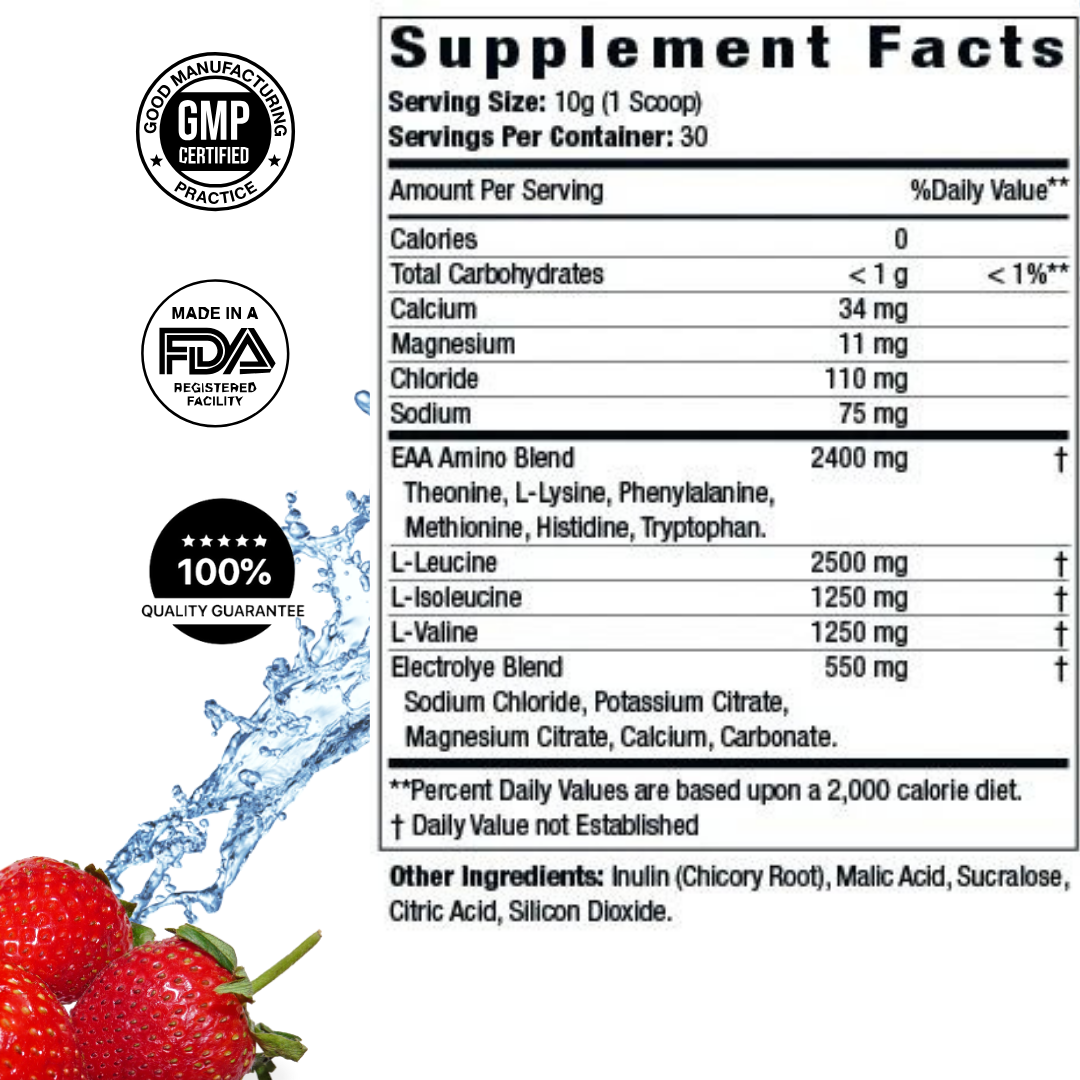
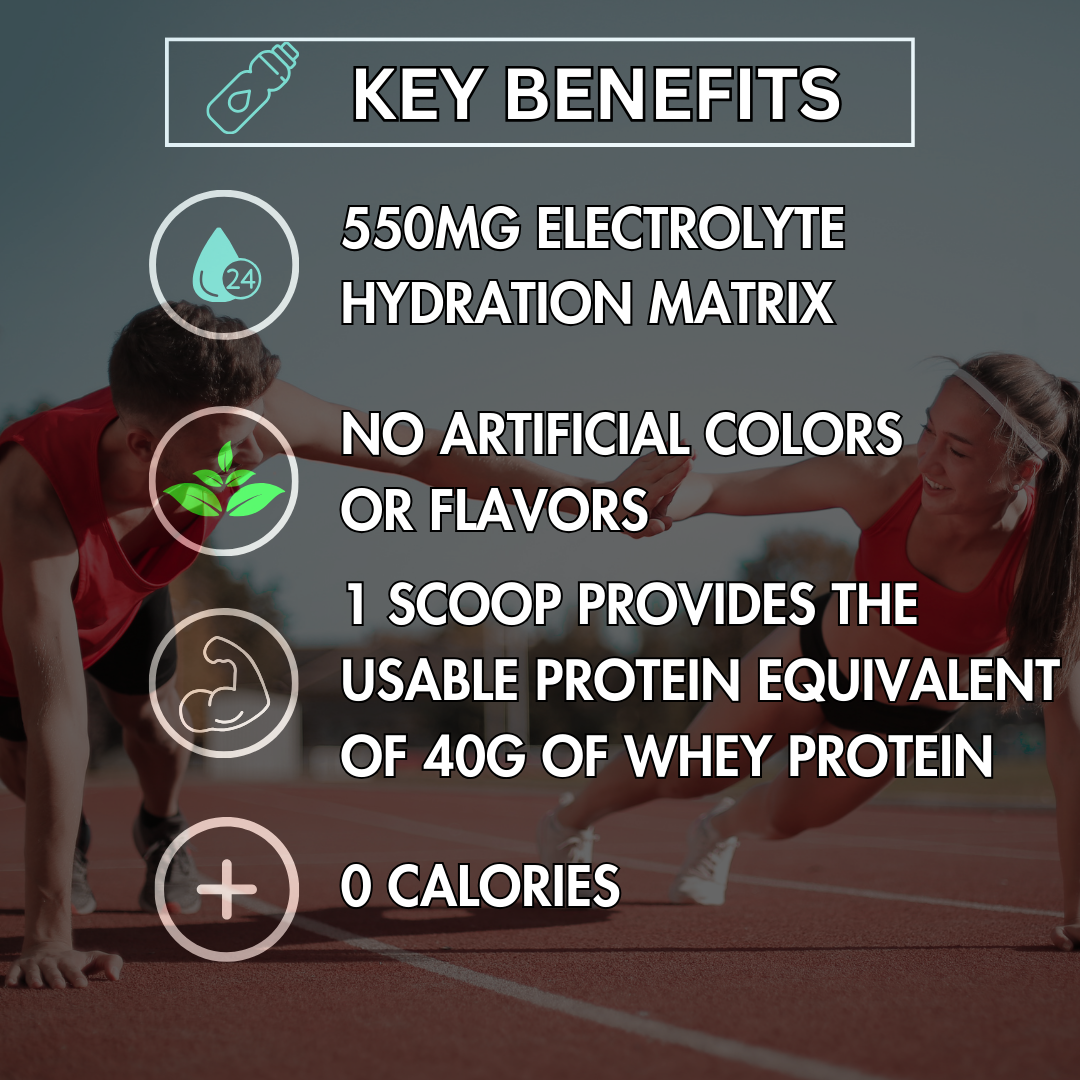
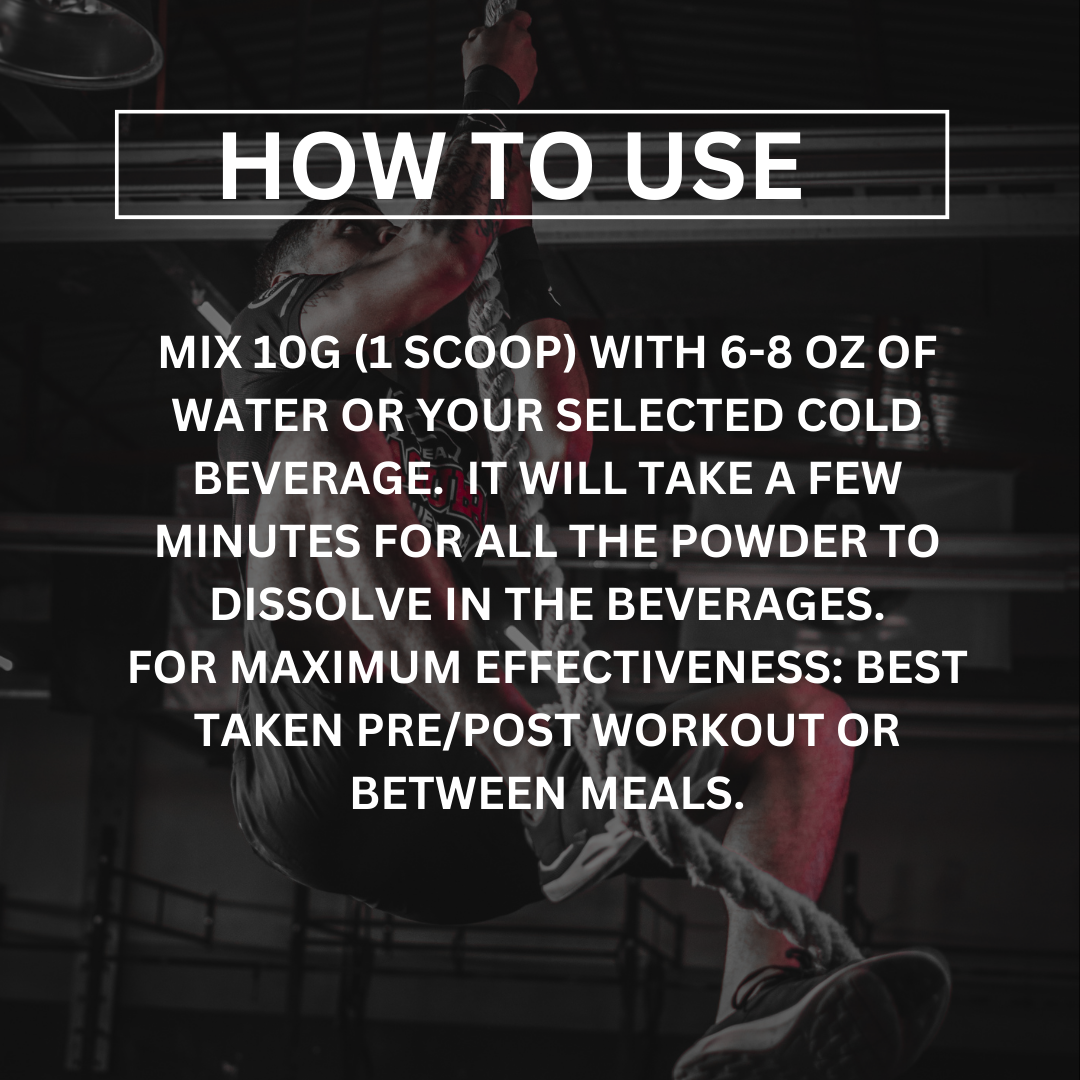

3-5x More Efficient
For Lean Muscle Growth | Recovery
Essential Amino Acids (EAAs) are the building blocks of protein. Amino acids promote muscle growth, fat loss, and recovery.
Just 1 scoop of Recovery provides as much usable protein as 40g of whey with zero calories.
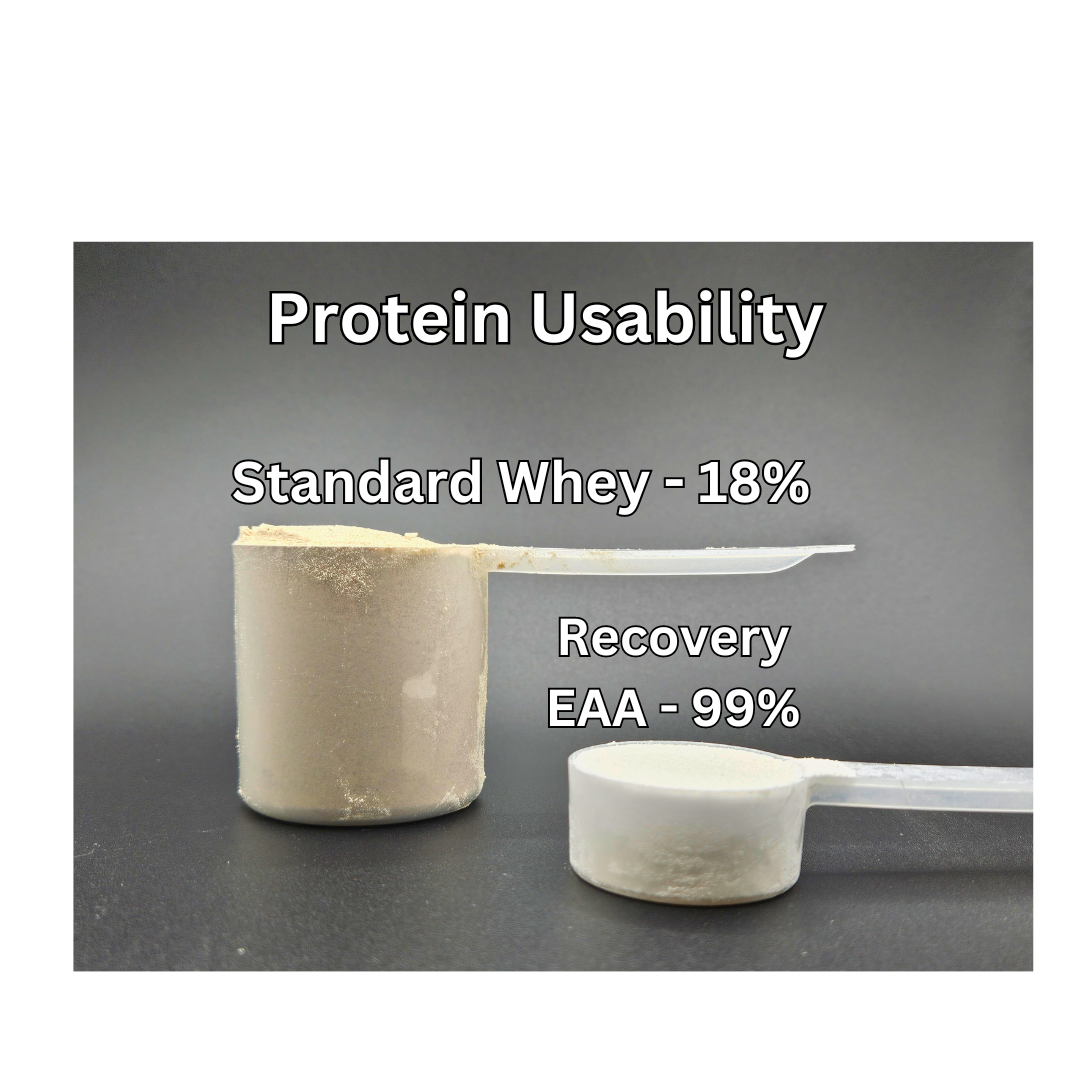
Know the difference
Standard Whey vs Recovery EAA
For protein synthesis to occur, all 9 essential amino acids (EAAs) must be present and in the correct ratio. Otherwise, the protein becomes less usable. Standard protein supplements contain imbalanced EAAs, nonessential amino acids, and high-calorie fillers.
In studies, just 18% of whey protein was utilized by the body. 1

Replace what you lost!
Electrolytes
Recovery is a supplement that incorporates the building blocks of protein, amino acids, and electrolytes to start the building and repair process in the body. You are not only replacing lost salt, potassium, and minerals but also the building blocks of protein, essential amino acids!
Recover | Build Lean Muscle | Better Performance
Frequently Asked Questions
How does 1 scoop of Recovery EAA provide as much as 40g of whey?
Being that we don't calculate EAAs into our macros we need to make a directly comparable source to provide a simplified calculation of grams per protein.
Let's use a 5oz steak as an example:
For about 35g of protein from a steak, you only get about 20% of that protein actually converted to amino acids through digestion. So 35g of protein x 0.2 = roughly 7 grams of amino acids which are the actual building blocks needed for your muscles. Recovery contains 7.4 grams per scoop of amino acids at a 99% absorption rate. Your body doesn't need to break it down, it will just be absorbed.
So 35 grams of protein from a regular source = ~ 7g of EAAs.
50g = ~ 10g of EAAs and so on.
For Whey Protein: About 18% is utilized by the body. Using the same mathematical data by the research above would imply that 40g of whey protein x 0.18 is equivalent to roughly 7.2 grams of EAAs. Research suggests that 10g of EAAs would be over 50g from an ordinary whey supplement.
How many scoops should I take?
Recovery contains 7g of EAAs per serving. Regarding safe amounts of each EAA, this data indicates that more than 100 g of supplemental EAAs can be safely consumed per day in an American adult already consuming the average habitual dietary intake of approximately 40 grams per day. Reasonable dosage means that even as much as three maximal doses per day is in line with normal daily consumption of EAAs through dietary protein food sources. [7]
Example: Using the daily protein requirement of 0.8 - 1lb of desired bodyweight.
I am a 200lb athletic male. I can take 5 scoops throughout the day equivalent to about 200g of protein for 0 calories. So, 7g of Recovery x 5 scoops = 35grams consumed out of 100, without food. If I ate food, based on the average American naturally consuming 40grams, I would still be under the safe amount of 100g per day.
A female who wants to weigh 160lbs. She would safely be a able to take 4 scoops, equivalent to about 160g of protein.
Who should take Recovery EAA?
Recovery ideal for lifters, athletes, the elderly, and anyone looking to promote lean muscle gains. Recovery was created for those who have trouble meeting their daily protein goals and would benefit from a zero calorie, more efficient, muscle building supplement in conjunction with their diet. It will be easier to lose weight with less calories per day, promote lean muscle growth, and aid in recovery.
What does each EAA do?
Each one is essential, meaning you must obtain it from a food source - your body will not produce it. These foods include beef, poultry, fish, eggs, dairy, soy, quinoa and buckwheat.
Here's what each of those amino acids does:
TRYPTOPHAN - Encourages the release of vital neurotransmitters and hormones for mood and sleep, such as serotonin and melatonin.*
LYSINE - If deficient, may result in a niacin deficiency (Vitamin B), as well as slow connective tissue repair.*
METHIONINE - Supplies sulfur and the other compounds you need for optimum metabolism and growth.*
VALINE - Needed for your muscle fibers to fire, for tissue repair, and for the maintenance of proper nitrogen balance in the body.*
LEUCINE - Stimulates muscle protein synthesis and may be the dominant fuel involved in anabolic (tissue building) reactions.*
ISOLEUCINE - Essential for blood sugar regulation, muscle development and repair, and energy regulation.*
THREONINE - Crucial for antibody production, immune system activity, and can be converted into glycine and serine.*
PHENYLALANINE - Stimulates the release of neurotransmitters and hormones, which are necessary substances for optimum activity of your central and peripheral nervous systems.*
HISTIDINE - is essential in globin synthesis and erythropoiesis and has also been implicated in the enhancement of iron absorption from human diets. *
How protein utilization works
Your body cannot produce the ones called "essential amino acids" on its own. It HAS to get them from outside sources.
When your body gets all of the essential amino acids from an outside source, it can use them to make any of the other "non-essential" amino acids it needs and they have to be in the right ratio. Non essential doesn't mean it's not important. Your body is very adaptive and the amino acids are just broken down further to fill in the gaps.
What do I mean by that? It's not as simple of having one of each. More of some are needed and less of others. Similar to a bicycle, it requires 2 tires, 1 frame, 1 handle bar, 1 chain, 2 brakes and 1 seat. You need all of those items to make a complete bike. Additional items like a bell or pouch are nice to have but not necessary to ride the bike.
The same is true when dealing with amino acids. Too much of one or another cannot be used and is excess. Similarly, excess non-essential amino acids are almost wholly not utilized. Only what the body NEEDS is used.
The body can't store amino acids for use later to pair them with new amino acids coming in, it has two choices. It can convert them to direct energy, glucose (blood sugar) and then eliminate them via the kidneys and urine, or it can store them as fat.
What determines that?
Your own metabolism. How much excess sugar can the body burn? That's why as we get older it's easier to gain weight and harder to lose it. The good thing about EAAs is that regardless of age, if the ratio is correct, your body will put them all to use.
What happens to unutilized protein?
NOT ALL PROTEIN IS BAD
There is nothing wrong with eating eggs in the morning or going out for dinner. You should still consume dietary foods. But it is important to know what happens to food when you consume it.
There are two pathways in the body. Catabolic and anabolic. In simple terms, Catabolic means un-used or wasted and Anabolic means simply used.
So when you eat a chicken breast, 32% of the amino acids from it get used (Anabolic). They are broken down and reconstituted as new muscle in your bicep, or tendons, skin, etc. But 68%, after being broken down, are not able to be used (Catabolic) as the necessary ratios of each of the amino acids are not present. These leftovers are turned into nitrogen waste and eliminated from the body.
Recovery is 99% anabolic. It is ALL used.
EAAs and their impact on low carb/keto diets
Sticking to a low-carb diet (or fasting) can actually be much easier when essential amino acids are present.
For starters, EAAs won’t break your state of ketosis, unlike major food sources of protein like steak and eggs. EAAs also allow you to maintain and build muscle — something you simply can't do with BCAAs alone.
Recovery enters your blood stream within about 30 minutes. It can be consumed during a strict, fat-based ketosis diet as a primary source of protein throughout the day for energy and performance.
Why does Direct Asset sell whey protein if Recovery EAA is 3-5x more efficient?
Simply put, Direct Asset wants to give customers options per their individual goals. We personally love the traditional protein flavors, and our isolate protein is ultra filtered making it a healthy alternative.
As long as you meet your daily protein goal of 0.8 - 1g per pound of bodyweight, I call that a win! The end goal is the same no matter which path you take! We understand what works for you may not work for another, so we take pride in having options for many individual need/wants.
EAA vs. Whey Protein Differences
While both EAAs and whey protein provide essential amino acids, there are some key differences between the two.
- Absorption Rate - EAAs are quickly absorbed by the body, which means they're readily available to fuel muscle growth, repair, and recovery. Whey protein takes longer to digest, so it's not as fast-acting as EAAs.
- Muscle Protein Synthesis - EAAs are more effective at stimulating muscle protein synthesis than whey protein. Muscle protein synthesis is the process by which our bodies build new muscle tissue, and it's essential for muscle growth and repair.
- Convenience - EAAs are easy to consume and don't require any digestion, making them a convenient option for on-the-go individuals. Whey protein, on the other hand, requires mixing and can be more difficult to consume when you're away from home.
Which is right for me Recovery EAA or Whey?
The answer to this question depends on your goals and preferences. If you're looking for a fast-acting supplement that promotes muscle growth and repair, EAAs might be the way to go. However, if you're looking for a convenient and versatile protein source, our whey protein might be a better fit.
The key is to recognize that to get the most from your training, you need to be using one or the other or even in some situations both.
Which is better for weight loss?
We would suggest Recovery EAAs. It contains 0 calories and gives you as much as 40g of whey protein per scoop. Opposed to 2 scoops of whey protein (about 250 calories) + 8-10 oz. of milk (about 400 total).
How do electrolytes help?
- 75mg of SODIUM CHLORIDE. One of the most important electrolytes, mostly related to fluid, water regulation, and preventing heat cramps.
- POTASSIUM CITRATE is the best form of potassium supplement for absorption. It is easily absorbed by the body and is also effective in treating urinary tract infections and kidney stones
- 11mg of MAGNESIUM is involved in over 600 cellular reactions. Magnesium is important for many processes in the body, including regulating muscle and nerve function, blood sugar levels, and blood pressure and making protein, bone, and DNA.
- 34mg of Calcium. Calcium has a significant physiological role in the body. It is involved in skeletal mineralization, contraction of muscles, the transmission of nerve impulses, blood clotting, and secretion of hormones. The diet is the predominant source of calcium. Calcium is a predominately extracellular cation.
- 7400mg of EAAs in Recovery. Containing all nine essential amino acids, Recovery is optimized to make body protein, build muscles, repair injuries, speed recovery, and more.




